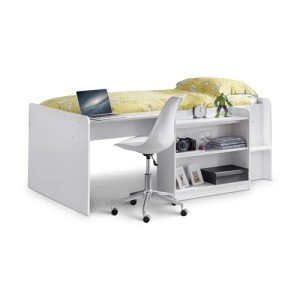The Midsleeper: A Practical Solution for Kids' Bedrooms
When it pertains to maximizing space in a child's bedroom, the midsleeper bed stands out as an innovative and practical solution. Combining the elevated structure of a loft bed with the ease of access of a traditional bed, midsleepers use an unique balance of play, storage, and sleeping services. This post will delve into the features, advantages, and factors to consider of midsleeper beds, using parents a thorough guide to understanding this functional furnishings piece.
What is a Midsleeper Bed?
Midsleeper beds rise beds that normally have a sleeping location raised off the ground, but not as high as a standard loft bed. This enables for an area below that can be made use of for numerous functions-- whether it's for storage, a play location, or a study area. Midsleepers usually cater to children and are created with security and performance in mind.
Secret Features of Midsleeper Beds
- Height: Midsleepers are typically in between 1.2 to 1.5 meters tall, making them accessible for kids while guaranteeing they are safe.
- Under-bed Space: The location below the bed is typically utilized for additional furniture or activities, including desks, wardrobes, or play areas.
- Security Features: Most midsleepers come equipped with guardrails and ladders that abide by security requirements, providing comfort for parents.
- Design and Customization: Available in different styles, colors, and designs, midsleepers can be customized to fit any décor, making them a versatile choice in kids's furnishings.
- Storage Solutions: Many midsleepers consist of integrated storage choices, such as drawers or racks, to help keep the bed room arranged.
Advantages of Choosing a Midsleeper Bed
Midsleepers supply many benefits that make them a popular option for kids's bed rooms:
Space Efficiency
With the space-saving style of midsleepers, families can utilize the under-bed location for numerous functions. This can assist keep the floor devoid of clutter and develop a more organized environment.
Encouragement of Play and Creativity
The under-bed space motivates children to utilize their imagination. They can develop a play zone, integrating camping tents, slides, or perhaps a tiny castle, which promotes interactive play while ensuring the room stays neat.
Adaptability and Longevity
Midsleepers cater to children as they grow, enabling a transition from a backyard to a study zone. The added versatility means that these beds can adapt to the altering needs of a kid from toddlerhood to early teenage years.
Visual Appeal
With many styles offered, midsleepers can enhance the general visual of a space. Parents can choose styles that match existing furnishings or develop a whimsical environment that stimulates a child's creativity.
Considerations When Choosing a Midsleeper
Despite their various benefits, there are essential elements for parents to think about when picking a midsleeper:
- Room Size: Measure the available area in the bedroom to ensure it can accommodate a midsleeper without making the room feel cramped.
- Age and Size of the Child: Ensure that the height of the bed appropriates for your kid's age and size. The majority of midsleepers are safe for kids aged 6 and older due to their height.
- Safety Standards: Check for safety accreditations, making sure the midsleeper abides by local guidelines regarding children's furnishings.
- Access and Mobility: Consider how easily your child can access the bed. click through the following web page or stairs should be sturdy and firmly connected to promote ease of usage while likewise not being a tripping threat.
- Style and Storage Needs: Assess your kid's choices and the needed storage space. Decide for a midsleeper that complements the interior decoration of the room while satisfying storage requirements.
Table: Key Differences Between Various Bed Types
| Feature | Midsleeper | Loft Bed | Bunk Bed | Requirement Bed |
|---|---|---|---|---|
| Height | Medium (1.2 - 1.5 m) | High (above 1.5 m) | Two beds stacked together | Low (normally ground level) |
| Under-bed Space | Yes | Yes | Yes (only one bed area) | No |
| Recommended Age | 6+ | 8+ | 6+ | 2+ |
| Safety Features | Guardrails, strong ladder | Guardrails, durable ladder | Guardrails | None |
| Area Efficiency | High | Extremely High | Moderate | Low |
FAQs About Midsleeper Beds
1. What age appropriates for a midsleeper bed?
Midsleeper beds are normally suggested for kids aged six and older, guaranteeing they can securely browse the height and structure of the bed.
2. Do midsleeper beds need unique mattresses?
Midsleeper beds generally use basic single or twin mattresses, however it is vital to inspect the manufacturer's standards for particular recommendations relating to density or size.
3. How can I ensure my kid is safe in a midsleeper?
To promote safety, guarantee that the bed is established properly, familiarize your kid with using the ladder, and check that guardrails are set up and safe and secure.
4. Can I personalize a midsleeper bed?
Yes! Many midsleepers come in various styles and can be personalized with accessories such as tents, slides, and storage options to match your child's choices.
5. Are midsleepers simple to put together?
Most midsleeper beds come with simple assembly instructions, enabling moms and dads to set them up without expert help. However, it's recommended to have an additional pair of hands to assist.
Midsleeper beds provide an excellent option for households seeking to optimize space in kids's spaces while providing a safe and fun sleeping plan. With their flexible styles, security features, and myriad choices for modification, they cater to the requirements of growing children and adapt as those requirements alter. By thoroughly thinking about aspects such as room size, security standards, and aesthetic choices, parents can pick the best midsleeper to boost organization and motivate creativity in their child's bed room.

